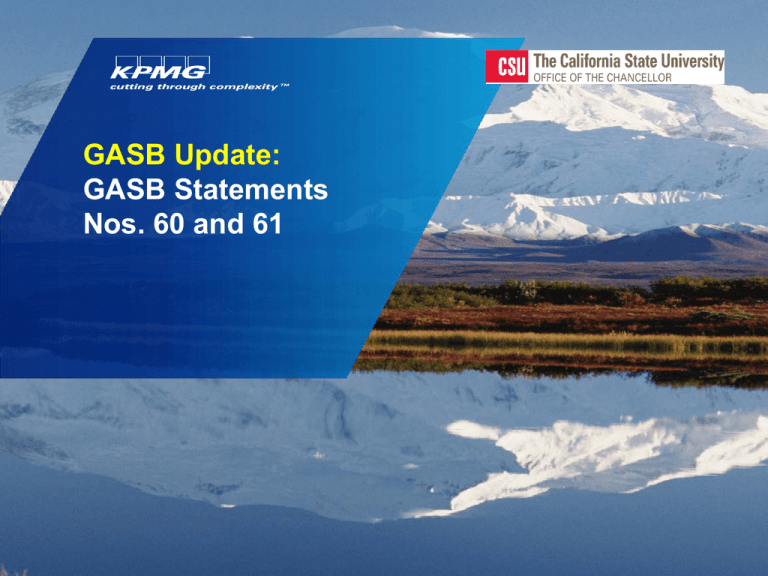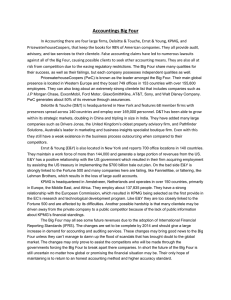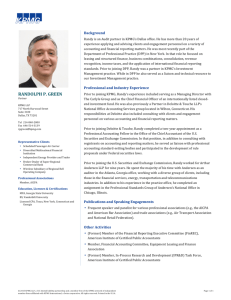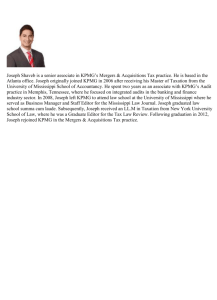
GASB Update:
GASB Statements
Nos. 60 and 61
Introduction
Two new GASB Pronouncements effective July 1, 2012
• GASB Statement No. 60: Accounting and Financial Reporting for
Service Concession Arrangements
Effective Date: For periods beginning after December 15, 2011
CSU: July 1, 2012
• GASB Statement No. 61: The Financial Reporting Entity: Omnibus,
an amendment of GASB Statements No. 14 and No. 34
Effective Date: For periods beginning after June 15, 2012
CSU: July 1, 2012
© 2011 KPMG LLP, a Delaware limited liability partnership and the U.S. member firm of the KPMG network of independent member firms affiliated with KPMG International
Cooperative (“KPMG International”), a Swiss entity. All rights reserved.
1
GASB 60: Service Concession Arrangements
What is a Service Concession Arrangement?
• A type of Public-Private or Public-Public Partnership
• An SCA may provide the government with the ability to leverage
existing infrastructure and other public assets to generate
additional available resources for the right to operate such assets.
• SCAs may be used to provide services to the general populace in
a more efficient and cost-effective manner.
© 2011 KPMG LLP, a Delaware limited liability partnership and the U.S. member firm of the KPMG network of independent member firms affiliated with KPMG International
Cooperative (“KPMG International”), a Swiss entity. All rights reserved.
2
GASB 60: Service Concession Arrangements
SCA’s are technically defined as:
An arrangement between a government (transferor) and an operator
in which ALL of the following criteria are met:
1. The transferor conveys to the operator the right and related
obligation to provide public services through the use and
operation of a capital asset in exchange for significant
consideration.
2. The operator collects and is compensated by fees from third
parties.
3. The transferor determines or has the ability to modify or approve
what services the operator is required to provide, to whom the
operator is required to provide the services, and the prices or
rates that can be charged for the services.
4. The transferor is entitled to significant residual interest in the
service utility of the facility at the end of the arrangement
© 2011 KPMG LLP, a Delaware limited liability partnership and the U.S. member firm of the KPMG network of independent member firms affiliated with KPMG International
Cooperative (“KPMG International”), a Swiss entity. All rights reserved.
3
GASB 60: Service Concession Arrangements
Examples of SCAs:
• Arrangements in which the operator will design and build a facility
and will obtain the right to collect fees from third parties (lease)
• Arrangements in which the operator will provide significant
consideration in exchange for the right to access an existing
facility (for example, a parking garage) and collect fees from third
parties for its usage
• Arrangements in which the operator will design and build a facility
for the transferor (for example, a new dormitory), finance the
construction costs, provide the associated services, collect the
associated fees, and convey the facility to the government at the
end of the arrangement.
© 2011 KPMG LLP, a Delaware limited liability partnership and the U.S. member firm of the KPMG network of independent member firms affiliated with KPMG International
Cooperative (“KPMG International”), a Swiss entity. All rights reserved.
4
Application to California State University
Potential SCAs at the CSU . . .
Library
Bookstore
Franchise Stores/Restaurants
Student Union
Food Service
Industrial Complex/Strip Mall
Student and Faculty Housing
Hotels/Catering
Auxiliary Organizations
Sports Complex
Foundations
Energy Providers
Parking
Public Radio
© 2011 KPMG LLP, a Delaware limited liability partnership and the U.S. member firm of the KPMG network of independent member firms affiliated with KPMG International
Cooperative (“KPMG International”), a Swiss entity. All rights reserved.
Associated Students
5
New Accounting and Reporting Requirements
Transferor Accounting and Financial Reporting
1. If the facility associated with an SCA is an existing facility, the transferor
should continue to report the facility as a capital asset.
2. If the facility associated with an SCA is a new facility purchased or
constructed by the operator, or an existing facility that has been
improved by the operator, the transferor should report
(a) The new facility or the improvement as a capital asset at fair value
when it is placed in operation,
(b) Any contractual obligations as liabilities, and
(c) a corresponding deferred inflow of resources equal to the difference
between (a) and (b).
© 2011 KPMG LLP, a Delaware limited liability partnership and the U.S. member firm of the KPMG network of independent member firms affiliated with KPMG International
Cooperative (“KPMG International”), a Swiss entity. All rights reserved.
6
New Accounting and Reporting Requirements
Transferor Accounting and Financial Reporting (con’t)
3. A transferor should recognize a liability for certain obligations to
sacrifice financial resources under the terms of the arrangement
(required improvements, maintenance, insurance, police
services).
4. After initial measurement, the capital asset is subject to existing
requirements for depreciation. However, the capital asset should
not be depreciated if the arrangement requires the operator to
return the facility to the transferor in its original or an enhanced
condition. The corresponding deferred inflow of resources
should be reduced and revenue should be recognized in a
systematic and rational manner over the term of the
arrangement, beginning when the facility is placed into
operation.
© 2011 KPMG LLP, a Delaware limited liability partnership and the U.S. member firm of the KPMG network of independent member firms affiliated with KPMG International
Cooperative (“KPMG International”), a Swiss entity. All rights reserved.
7
New Accounting and Reporting Requirements
Operator Accounting and Financial Reporting (applicable
only if the operator is a GASB organization)
1. An operator should recognize an intangible asset at cost for its
right to access the facility and collect third party fees, then
amortize it over the term of the arrangement.
2. For existing facilities, the operator’s cost may be an up-front
payment or the present value of installment payments.
3. For new or improved facilities, the operator’s cost may be its
cost of improving the existing facility or constructing or
acquiring a new facility.
© 2011 KPMG LLP, a Delaware limited liability partnership and the U.S. member firm of the KPMG network of independent member firms affiliated with KPMG International
Cooperative (“KPMG International”), a Swiss entity. All rights reserved.
8
New Accounting and Reporting Requirements
Other Considerations
• Provisions also apply to GASB Auxiliary Organizations
• Requirements include enhanced disclosures in the financial
statements for SCAs
• Campuses/Auxiliaries may qualify as Operators, with additional
accounting/reporting requirements
• The Statement also addresses SCAs where there is revenue
sharing
© 2011 KPMG LLP, a Delaware limited liability partnership and the U.S. member firm of the KPMG network of independent member firms affiliated with KPMG International
Cooperative (“KPMG International”), a Swiss entity. All rights reserved.
9
New Accounting and Reporting Requirements
Implementation Steps for CSU
• Start early and plan ahead before 7/1/2012.
• Carefully evaluate potential SCAs at CSU to determine whether
they meet the four criteria in the SCA definition.
• The CO will provide a sample matrix for the criteria in the SCA
definition.
• If all four criteria are met, then it is an SCA.
• If no capital asset is used in providing the services, then it is a
service management agreement (SMA).
• If the operator is compensated by the transferor, not by users of
service recipients, then it is an SMA or construction contract.
© 2011 KPMG LLP, a Delaware limited liability partnership and the U.S. member firm of the KPMG network of independent member firms affiliated with KPMG International
Cooperative (“KPMG International”), a Swiss entity. All rights reserved.
10
New Accounting and Reporting Requirements
Implementation Steps for CSU (cont’d)
• If the transferor does not retain control over the facility (i.e., the
transferor does not determine or have the ability to modify or
approve the services the operator can provide, to whom the
operator can provide the services, and the rates that can be
charged), then it is a lease.
• If the transferor does not retain a significant residual interest in
the asset, then it is a privatization, which is accounted for as a
sale/purchase.
• Contact the CO Systemwide Reporting team if you need help or
send an email to FSSR@calstate.edu.
© 2011 KPMG LLP, a Delaware limited liability partnership and the U.S. member firm of the KPMG network of independent member firms affiliated with KPMG International
Cooperative (“KPMG International”), a Swiss entity. All rights reserved.
11
GASB Statement 61: The Reporting Entity
GASB Statement 61: The Reporting Entity
Modifies Requirements for Inclusion of Component Units
Specifically, it modifies the following:
• Misleading to Exclude criterion
• Fiscal Dependency criterion
Modifies Requirements for Blended vs. Discrete Presentation
of Component Units
Requires BTA reporters to include condensed combining
information for Blended Component Units in the Notes
© 2011 KPMG LLP, a Delaware limited liability partnership and the U.S. member firm of the KPMG network of independent member firms affiliated with KPMG International
Cooperative (“KPMG International”), a Swiss entity. All rights reserved.
13
GASB Statement 61: The Reporting Entity
Changes to the Misleading to Exclude criterion
Requirements were amended to clarify the manner in which the
"misleading to exclude" provisions should be applied in making the
inclusion/exclusion decision.
“Other organizations should be evaluated as potential component
units if they are closely related to, or financially integrated with, the
primary government. It is a matter of professional judgment to
determine whether the nature and the significance of a potential
component unit's relationship with the primary government
warrant inclusion in the reporting entity.”
© 2011 KPMG LLP, a Delaware limited liability partnership and the U.S. member firm of the KPMG network of independent member firms affiliated with KPMG International
Cooperative (“KPMG International”), a Swiss entity. All rights reserved.
14
GASB Statement 61: The Reporting Entity
Changes to the Financial Accountability criterion
In addition to meeting the fiscal dependency criterion, a financial
benefit or burden relationship must also be present in order for a
potential component unit to be included in the financial reporting
entity based on that concept.
“The primary government is financially accountable if an
organization is fiscally dependent on and there is a potential for the
organization to provide specific financial benefits to, or impose
specific financial burdens on, the primary government.”
© 2011 KPMG LLP, a Delaware limited liability partnership and the U.S. member firm of the KPMG network of independent member firms affiliated with KPMG International
Cooperative (“KPMG International”), a Swiss entity. All rights reserved.
15
GASB Statement 61: The Reporting Entity
Changes to the Blending Requirements
Blend if:
A. The component unit's governing body is substantively the same
as the governing body of the primary government, and
(1) there is a financial benefit or burden relationship between
the primary government and the component unit, or
(2) management of the primary government has operational
responsibility for the component unit.
B. The component unit provides services entirely, or almost entirely,
to the primary government or otherwise exclusively, or almost
exclusively, benefits the primary government even though it does
not provide services directly to it.
© 2011 KPMG LLP, a Delaware limited liability partnership and the U.S. member firm of the KPMG network of independent member firms affiliated with KPMG International
Cooperative (“KPMG International”), a Swiss entity. All rights reserved.
16
GASB Statement 61: The Reporting Entity
Changes to the Blending Requirements (con’t)
C. The component unit's total debt outstanding, including leases, is
expected to be repaid entirely or almost entirely with resources
of the primary government.
© 2011 KPMG LLP, a Delaware limited liability partnership and the U.S. member firm of the KPMG network of independent member firms affiliated with KPMG International
Cooperative (“KPMG International”), a Swiss entity. All rights reserved.
17
GASB Statement 61: The Reporting Entity
Disclosures for Blended Component Units
(1) Condensed statement of net assets:
(a) Total assets — current assets, capital assets, and other
assets.
(b) Total liabilities— current and long-term amounts.
(c) Total net assets— invested in capital assets; restricted and
unrestricted
(2) Condensed statement of revenues, expenses, and changes in
net assets
(3) Condensed statement of cash flows
© 2011 KPMG LLP, a Delaware limited liability partnership and the U.S. member firm of the KPMG network of independent member firms affiliated with KPMG International
Cooperative (“KPMG International”), a Swiss entity. All rights reserved.
18
GASB Statement 61: The Reporting Entity
Flowchart for Evaluating Component Units
The paragraph references are those of Statement 14, as amended.
Next page
© 2011 KPMG LLP, a Delaware limited liability partnership and the U.S. member firm of the KPMG network of independent member firms affiliated with KPMG International
Cooperative (“KPMG International”), a Swiss entity. All rights reserved.
19
GASB Statement 61: The Reporting Entity
Flowchart for Evaluating Component Units
Prev page
© 2011 KPMG LLP, a Delaware limited liability partnership and the U.S. member firm of the KPMG network of independent member firms affiliated with KPMG International
Cooperative (“KPMG International”), a Swiss entity. All rights reserved.
20
GASB Statement 61: The Reporting Entity
Next Step:
Apply amended criteria to determine whether it changes the
financial reporting of any component units.
Some suggested Methods:
•
Flowchart (from previous slides)
•
Survey
•
Checklist
•
Task force
© 2011 KPMG LLP, a Delaware limited liability partnership and the U.S. member firm of the KPMG network of independent member firms affiliated with KPMG International
Cooperative (“KPMG International”), a Swiss entity. All rights reserved.
21







